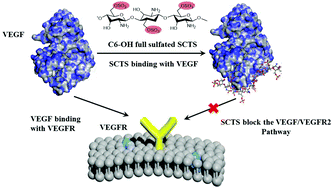Chitosan sulfate inhibits angiogenesis via blocking the VEGF/VEGFR2 pathway and suppresses tumor growth in vivo†
Abstract
Suppressing the angiogenesis in tumors by inhibiting the VEGF/VEGFR2 signaling pathway offers an important approach for cancer therapy. In this work, we developed a heparinoid angiogenesis inhibitor of sulphated chitosan (SCTS), which has a higher inhibitory activity and better safety compared with heparin. It can block the VEGF/VEGFR2 signaling pathway significantly and has a stronger inhibitory effect on the cellular migration and tube formation of HUVECs than heparin in the presence of VEGF in vitro as well. Other than this, SCTS showed an obvious inhibition in tumor size, which was 42.12% higher than the heparin group, and the results of immunohistochemistry showed that the inhibition rate of neovascularization in SCTS was significantly higher than for the heparin control (63.8% vs. 30.7%) at best. In addition, hemorrhage was never observed in the body during the entire process of the experiment, suggesting that it has no obvious anticoagulant activity and possesses good biocompatibility.



 Please wait while we load your content...
Please wait while we load your content...